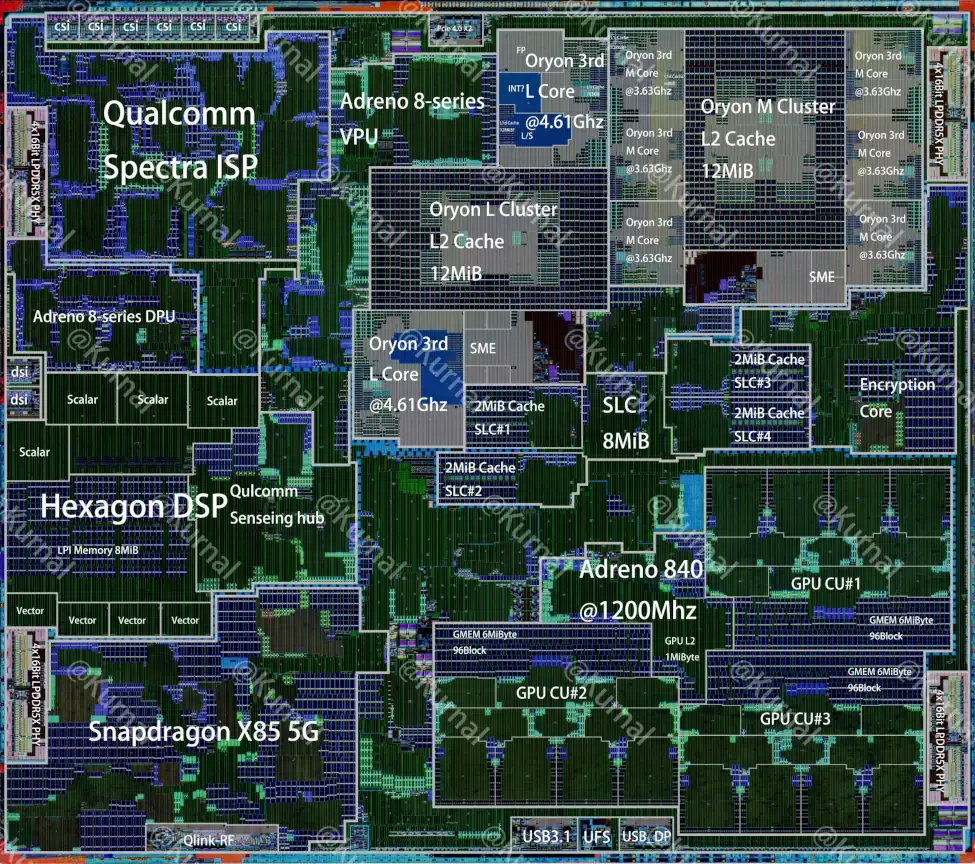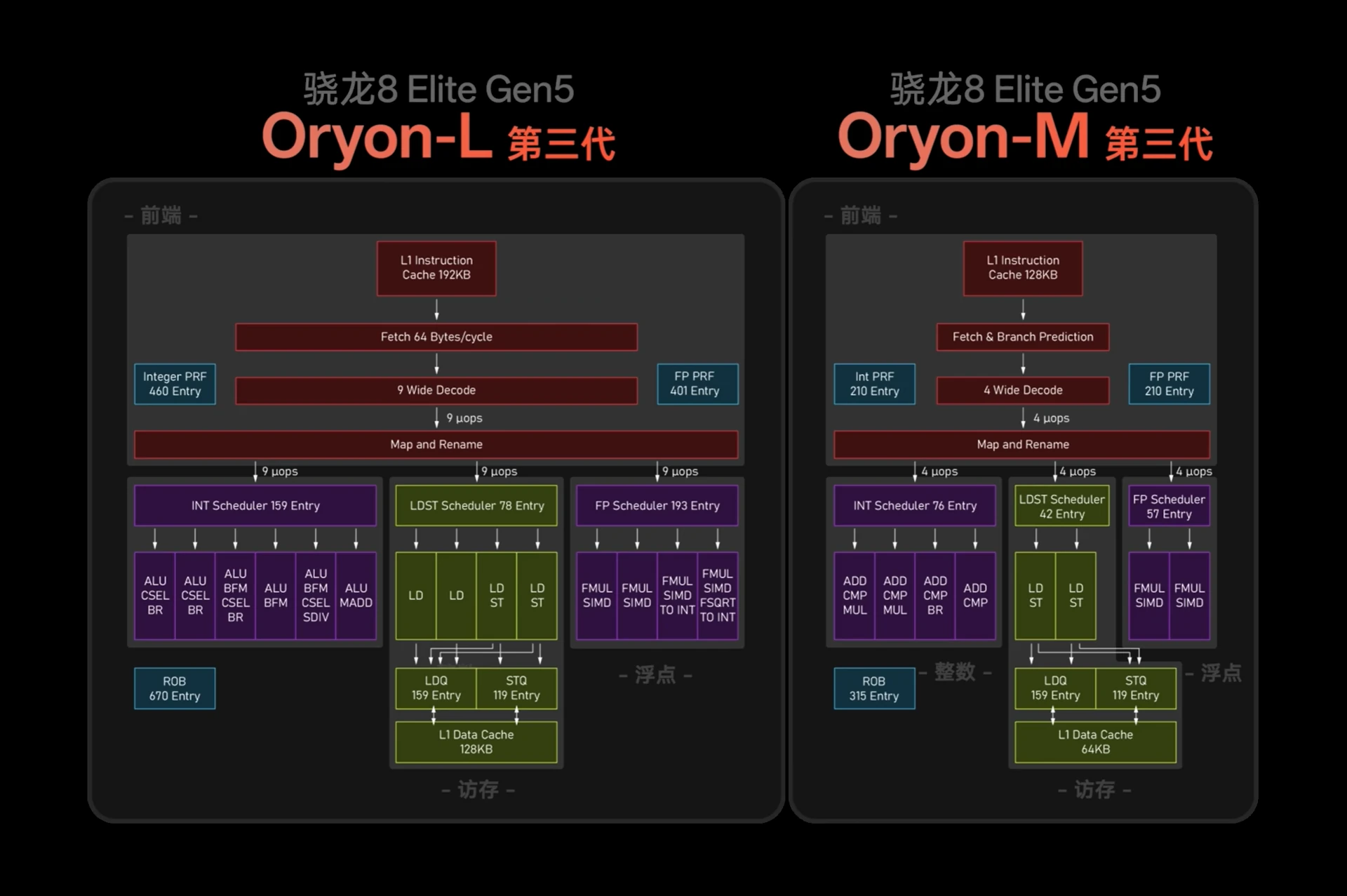Qualcomm has begun shipping the Snapdragon 8 Elite Gen 5 smartphone processor. Integrating revised versions of Qualcomm’s custom large and medium cores, its CPU complex is the fastest available for Android phones. Along with other smartphone-processor function units, the faster CPUs also appear in new Snapdragon X2 Elite processors for PCs. Boosting to 5 GHz in the Extreme model, the large core is the fastest-clocking Arm-compatible CPU.
The Gen 5 also raises graphics performance, but it trails that of its main competitor. The smartphone chip also receives upgraded multimedia features and AI acceleration. Capitalizing on the newest trend in AI hype, Qualcomm touts how the acceleration enables agentic functions in a smartphone.
Name Decoder

CPU Complex
The Snapdragon 8 Elite Gen 5 integrates two large (Oryon-L) and six medium (Oryon-M) cores, analogous to the Arm Lumex C-1 Ultra and Pro CPUs. Employing only two CPU types, the Gen 5’s configuration differs from MediaTek’s use of a single instance of Arm’s highest-performance core, three of Arm’s space-optimized Premium versions of the Ultra microarchitecture, and four Pro cores. On balance, Qualcomm’s bias toward higher clock rates and twin prime cores gives it an advantage over its rival in peak multicore throughput.
Oryon-L
Qualcomm reports a 20% improvement in single-core performance compared with the earlier Snapdragon 8 Elite. YouTube channel @Geekerwan1024 (Geek Bay) confirms a 19% boost on Geekbench. The Oryon-L scores 4% above the Arm Lumex C-1 Ultra (presumably in the MediaTek Dimensity 9500), and it’s in line with Apple’s new A19 processor but behind the A19 Pro.
The gain results from a combination of higher clock speed, greater instruction throughput (IPC), and added matrix-math (SME2) support. The new CPU operates at a peak frequency of 4.6 GHz, compared with its predecessor’s 4.3 GHz. The speedup derives from the TSMC N3P process, design optimizations, and power management that likely allows brief high-power, high-speed bursts.
The new Oryon-L makes numerous small microarchitectural changes to raise IPC. At 192 KB, the instruction cache is 50% larger. Decoding and dispatching increase from eight to nine operations per cycle. Function-unit composition is unchanged, but the integer register file grows by about 25%, which should allow more instructions to be in flight. As for SME2, the floor-plan analysis by Twitter user @Kurnalsalts shown in Figure 2 suggests the Gen 5 has two units. The newest Geekbench version includes subtests that benefit from SME2, possibly pulling up the overall score by 5%.

Despite having a lower IPC that offsets its higher peak clock rate, the Oryon-L leads the Arm C1 Ultra in Geekbench. The comparison with the Apple A19 Pro is similar, but its even greater IPC more than offsets its clock-rate disadvantage.
Oryon-M
A four-way CPU, the Oryon-M is a pint-sized Oryon-L, as Geekerwan’s analysis shows in Figure 3. The new version receives a 100 MHz boost to 3.6 GHz, putting it well ahead of the 2.7 GHz Arm Lumex C1 Pro in the rival Dimensity 9500. The C1 Pro is a five-way design with more execution resources than the Oryon-M; it should deliver greater instruction throughput—but not 33% greater. Thus, the Oryon-M should have higher peak performance and possibly better power efficiency. Moreover, because it supports a larger frequency range, power should be easier to manage.

Indeed, Geekerwan finds the Oryon-M to be more efficient than the C1 Pro. Qualcomm reports that the Gen 5’s multicore energy efficiency is up by 35% over the Snapdragon 8 Elite, indicating that architecture, circuit design, and backend implementation, together with the new fabrication process, have reduced power even as they raised performance. Geekerwan also reports the Gen 5’s multicore performance per watt tops that of the A19 Pro and greatly exceeds that of the Dimensity 9500.
GPU
By the metrics alone, the Gen 5’s GPU is a significant upgrade, but it’s falling behind competitors. Qualcomm enlarged the GPU cache by 50% to 18 MB and may have made other changes to justify its boast of a new high-performance memory. Clock rate is up 100 MHz to 1.2 GHz. These changes raise overall performance by 23% and ray-tracing throughput by 25%. Although infrequently used, ray tracing is a strength of the competing Arm Mali G1 Ultra GPU.
Qualcomm also implemented a direct link between the GPU and the Gen 5’s main AI accelerator (NPU), enabling data exchange without CPU intermediation. It had previously done the same for the image processor (ISP) and NPU. It’s unclear if the NPU’s latency is low enough to support frame generation and resolution upscaling for graphics workloads. There could be utility in splitting AI workloads between the units. However, 16-bit floating-point (FP16/BF16) operations—common in AI—may not have sufficient throughput for AI processing.
NPU
However, most AI operations will run on the NPU, which Qualcomm has enlarged considerably. The Gen 5’s AI accelerator adds a tensor (matrix-math) unit and more scalar and vector cores. The company reports that a 3 billion-parameter large language model (LLM) runs 37% faster. The context window for this model grows eightfold to 32K tokens. Performance per watt, surprisingly, climbs only 16%. The NPU supports integer types ranging from 2 bits to 16 bits and floating-point types of 8 and 16 bits. However, it doesn’t support BF16 or an FP4 format. Four-bit block formats are becoming the leading alternatives to INT8 for reduced-precision inference.
As in the previous generation, the new Snapdragon smartphone processor has a sensing hub, a low-power unit for analyzing audio, video, images, and other information in the background. These abilities position the hub to help a smartphone act agentically, making recommendations or acting on the basis of user habits and analysis of information flowing through the device.
Multimedia
The Gen 5 offers improved audio/video capabilities. Qualcomm raised the precision of the Gen 5’s image processors (ISPs) from 18 bits to 20 bits. Although optical sensors don’t capture images to this level (a high-end one could have 14-bit output), the added precision mitigates over- and underflow during processing.
Because the ISP and the main NPU can communicate directly, both can be part of an image-processing pipeline. Qualcomm highlighted ArcSoft’s Dragon Fusion pipeline for enhancing video quality. Also video-related, the Gen 5 supports the Advanced Professional Video (APV) codec. Originated by Samsung, the APV is royalty free and delivers better quality than H.265.
Audio quality also improves with the Gen 5. Snapdragon Audio Sense combines MEMS microphones with on-chip processing to reduce noise and improve sound quality.
Communications
Qualcomm is a leader in 5G radios, and the new smartphone processor integrates its X85 modem. Theoretical peak data rates exceed real-world feasibility, but the new design should provide greater throughput/range and quality of service (traffic prioritization). Like its predecessor, the Gen 5 supports satellite-based networks (NTN). Its companion connectivity chip is unchanged from last year and supports Wi-Fi, Bluetooth, and UWB.
PC-Processor Sibling
Alongside the smartphone-targeted Gen 5, Qualcomm also demonstrated the Snapdragon X2 Elite in extreme and even-keeled editions. The X2 integrates as many as 18 CPUs, divided between 12 Oryon-L and 6 Oryon-M cores. Owing to the greater PC power envelope, the X2 can temporarily boost an Oryon-L pair to 5.0 GHz. This is the highest speed of any available Arm-compatible CPU.
We expect a single core to score close to the forthcoming Apple M5 on independent benchmark tests; the M5 may clock slower but deliver greater per-cycle instruction throughput. Compared with AMD and Intel offerings, the results will depend on power constraints. Qualcomm has withheld the X2’s power (TDP), and x86 processors—even for laptops—can have high TDPs. Assuming a 35 W configuration, we expect the X2 to crush the x86 processors in single-thread comparisons.
The X2 also features an NPU upgraded to 80 TOPS compared with its predecessor’s 45 TOPS. Although the NPU was the original Snapdragon X’s key feature, a botched Microsoft rollout and a lack of NPU-using applications have delayed the relevance of AI acceleration in the PC market. In short, NPU throughput is not holding the market back.
As for other features, the X2 also upgrades the X’s GPU. However, compatibility, not GPU performance, holds back PC consumers’ acceptance of Qualcomm’s offering. For the corporate market, Qualcomm has added security and management capabilities.
The X2 supports the Qualcomm X75 5G modem and FastConnect 7800 connectivity chip. In this context, support means OEMs can add separate ICs to their designs. The X75 and 7800 are older versions of the modem and connectivity chip associated with the Gen 5 smartphone processor.
Bottom Line
Smartphone processors are the most functionally diverse chips, integrating state-of-the-art modems, CPUs, multimedia capabilities, GPUs, and NPUs. In Qualcomm’s flagship Snapdragon 8 series, most function units receive annual updates to propel the series’s new-release cadence. Now that the industry is in the middle of the 5G lifecycle, communications upgrades have taken a back seat to other improvements, such as to AI accelerators and CPUs.
In recent years, Qualcomm has demonstrated image generation and large language models to show off its smartphone processors’ AI capabilities. A gap separates these glitzy demos from real-world use cases, but NPUs are proving useful in computational photography. This year, Qualcomm promoted agentic AI, the current hot AI topic. In the short run, agentic AI is as disconnected from reality as image generation, but we can’t blame the company for setting a north star for future development. Agentic AI doesn’t require hardware beyond the CPU and NPU technology already found in smartphone processors. If the units in today’s chips are insufficient, Qualcomm will have a better Snapdragon 8 next year.

